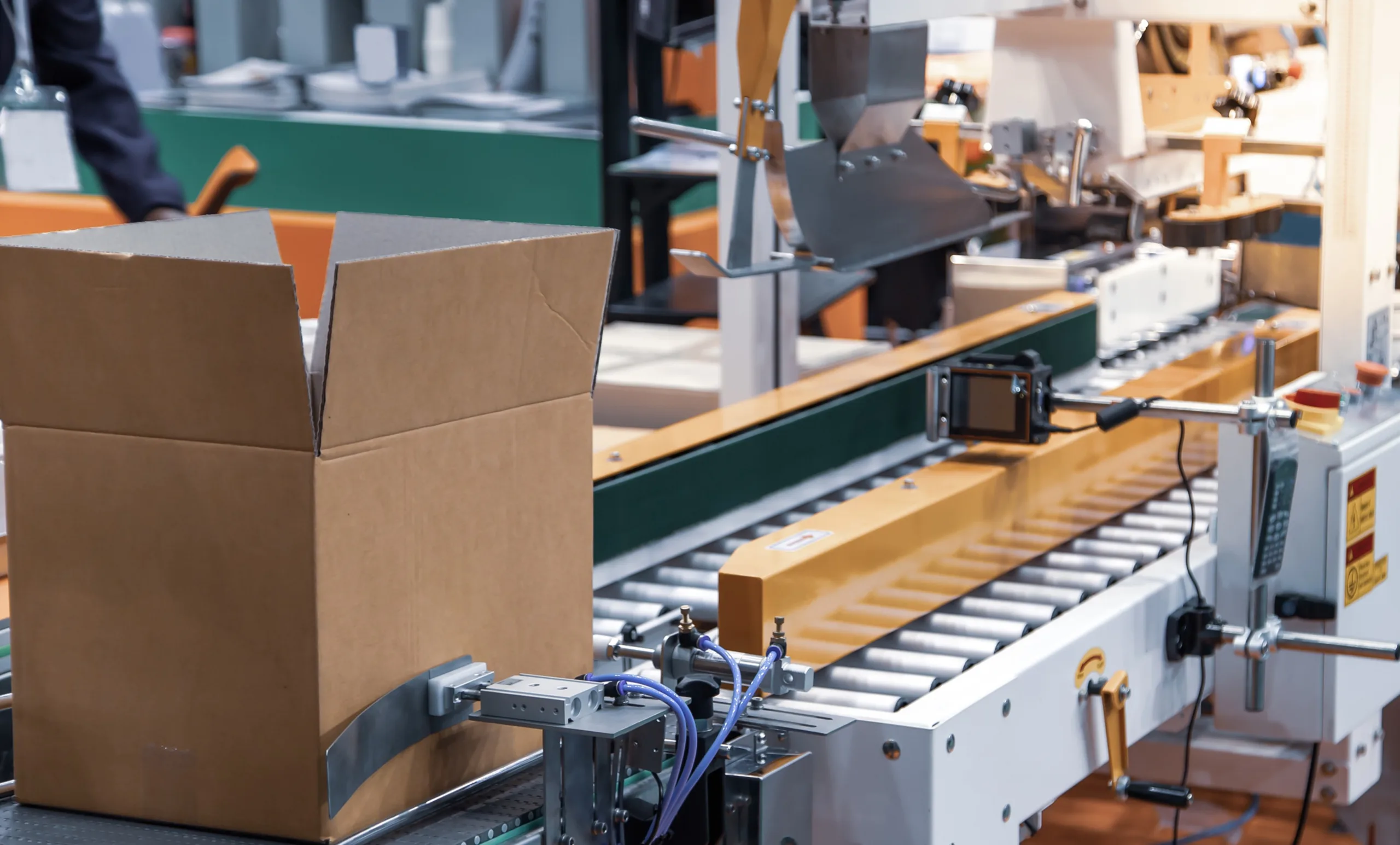Packaging automation: a quick guide

Packaging automation can be a powerful tool for businesses that need to ship large quantities of products quickly.
If you would like to increase productivity and shorten the time it takes to deliver products to customers, automated packaging systems and processes might be the answer.
With so many options available, you may be wondering which solution is the best for your operations. Don’t worry, we’ve got you covered!
In this blog article, we will define packaging automation, explore different types available and look at some of the key advantages and frequently asked questions related to packaging automation. Continue reading to find out more.
- 1.
- 2.
- 3.
-
4.
Frequently asked questions about packaging automation
- 4.1.
- 4.2.
- 4.3.
- 4.4.
- 4.5.
- 5.

Packaging automation – what exactly is it?
Packaging automation entails introducing automated equipment and machinery into your packing operation to accelerate the packing process.
This helps to assure consistency, avoid material waste, and save money in the long run. It also enables you to reallocate valuable resources to high-value jobs or in the most efficient method for your operation. Most areas of the packaging process can be improved by introducing automated packaging systems; from picking and packing to conveying and wrapping, there are packaging machines for it all.

What are the different types of packaging automation?
Erecting boxes, taping cartons, and wrapping pallets for shipment can all be automated. We distinguish between semi-automated and automated packing methods:
- A semi-automated packing process combines both human involvement with elements of automation. For example, an operator can start the process, but an automatic packing system will finish it. If you want to use automation but have a restricted budget, this is usually the most cost-effective option.
- An automated packing process is pre-programmed from start to end. It can handle everything from picking products, and packaging to palletising for shipping. This option is a good solution for operations where demand is high or that predict significant grow.
We distinguish between the following automation solutions, based on the product you’re using:
- Box automation – including solutions, such as case and box erectors, fully and semi-automated auto boxing machines as well as void reduction systems
- Tape automation – e.g. semi and fully automatic tape dispensers, in-line taping machines and carton sealers
- Bag automation – e.g. automated bagging machines and bulk bagging equipment
- Protective automation – including semi and fully automated void fill machines, air cushioning and air pillow machines
- Paper automation – e.g. paper wrapping equipment, paper void fill machines and paper cushioning systems
- Strapping automation – solutions such as: semi and fully automated strapping machines, friction welders, battery powered strapping tools and banding tables
- Stretch automation – e.g. fully and semi-automatic pallet wrappers, vertical and horizonal stretch wrapping machinesand rotating arm stretch wrap machines
- Polythene automation – e.g. shrink-wrapping machines,heat shrink tunnels, heat sealers, impulse heat sealers and vacuum packing machines
- Auxiliary equipment – solutions, such as: automated labelling equipment, case stackers, sorters, palletisers and conveyor systems

Key benefits of packaging automation
Packaging automation offers many benefits. It can help you to:
- Boost productivity, allowing you to pack more parcels in less time
- Save space, using fewer packaging SKUs and, therefore, saving storage space before parcels are packed (less packaging stored on site), as well as cubage, which saves transport space.
- Lower operating costs, resulting in savings on labour, storage, transportation, packing materials, and productivity
- Streamline workflow, ensuring your packaging process runs as smoothly as possible
- Reduce volume handling, relieving operational strain and helping better manage spikes in demand
- Assure pack optimisation and consistency, ensuring that the appropriate quantity and type of packaging is used every time
- Minimise material waste, making sure you only use the right amount of material required to protect your product during transit and avoiding overpacking
- Reduce transport and fuel costs, enabling you to pack more products onto a pallet. This will also help reduce your carbon footprint, as less fuel means fewer CO2 emissions.
- Ensure customer satisfaction,providing smart, beautifully packaged parcelsthat arrive with your customers damage-free
- Future-proof for growth and demand, increasing your capacity and helping control costs as your business grows.
Read our latest blog post – Automated packaging: 10 decisive benefits – to find out more about various benefits that comes with packaging automation.

Frequently asked questions about packaging automation
Below are some of the most frequently asked questions about packaging automation solutions, along with our answers. If there’s something you would like to learn more about that we haven’t covered below, please get in touch.
How do I automate my packing process?
There are many ways to automate your packing process. You can automate almost any part of it, but if you need pointers of where to start, you will need to review your packing operation first. This will help you identify any bottlenecks or processes that could be improved or automated.
Some of the common bottlenecks include:
- Picking accuracy – miss-picks can be a sign that something isn’t working or that capacity is being outstripped by demand.
- Packing times – have packing times met targets? Are packers taking longer to process orders? During high-pressure times, packing times can be a bottleneck if processes aren’t efficient and packing materials aren’t easy.
- Dispatch lead times – do your dispatch lead times keep increasing and getting longer? This can be in response to high demand, but it can also suggest that processes need to change.
- Damages – are customers reporting an increase in damages? This can be an indicator that packing isn’t being completed properly or that the packing materials being used aren’t sufficient.
How to choose the right packaging machine equipment?
The type of automation solution you need will depend on your products, processes, productivity goals and space in your warehouse. You will also need to factor in your budget.
There are lots of different types of packaging machinery available, from cardboard box and case erectors and auto-bagging machines through to pallet wrappers, heat shrink tunnels, in-line taping machines and many more!
What will packaging automation cost me?
Packaging automation can be an investment, depending on the solution you’re looking at. There may be a large upfront cost to purchase an automated packaging system, but the money you’ll save elsewhere in your operation will counterbalance this in the long run.
Not every system requires an initial outlay – many are available for rental or can be purchased through finance agreements. A free trial is available on many machines, which gives you the opportunity to test if the solution is right for your business. Plus, there are some cost-effective automation options out there, such as water-activated gummed paper tape dispensers. You can also opt for semi-automatic machines that can be found at a lower price point.
How do I calculate return on investment (ROI) for packaging automation?
The ROI for packaging automation is calculated by comparing the costs associated with implementing automation to the benefits it brings, including cost savings and increased productivity.
When calculating the cost of automation for your business, there are several factors to consider, including your initial investment, equipment costs, installation setup fees, staff training, and any projected long-term costs, such as maintenance and repair. Then, think about how much money you can save each year with packaging automation. This can include reducing labour costs, increasing productivity and throughput, reducing material waste, as well as improving product quality and consistency.
How do I futureproof the investment in packaging automation?
When you invest in packaging automation, it’s important to make strategic decisions and put processes in place to keep your packaging automated system running smoothly and up to date with the latest technologies and industry developments. Consider things such as regular and preventative maintenance, staff training, periodic calibration and testing of equipment as well as spare parts inventory.

Why choose Macfarlane as your automation partner?
At Macfarlane Packaging, we work closely with our customers on a case-by-case basis to find the best automated packaging solutions for their requirements.
We can offer a wide choice of automated packaging solutions to fit various demands and budgets, whether you need a pallet wrapper, water activated tape dispenser, carton sealer, case erector, or anything in between.
Contact us today to go over your packaging needs.
